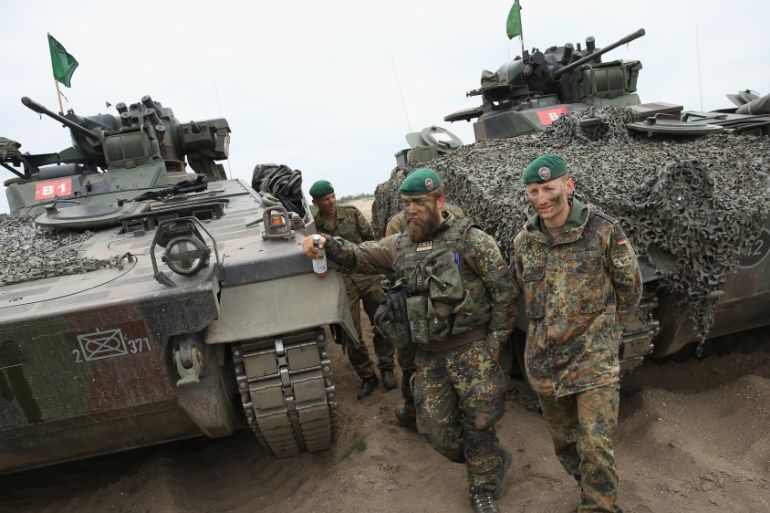For Eastern Europe, Moscow is an existential threat
If the US and NATO pursue a policy of defence and deterrence, Russia’s aggression will remained checked.

The United States’ recent announcement that it will pre-position a brigade’s worth of combat equipment in Eastern Europe is welcome news to members of the North Atlantic Treaty Organization (NATO) who have legitimate concerns about Russia’s designs on the region.
Predictably, the Kremlin is complaining. A Russian defence ministry official said stationing tanks in NATO states on Russia’s border would be “the most aggressive US act since the Cold War”.
Keep reading
list of 4 itemsNATO allies must do more as Ukraine runs out of ammunition: Stoltenberg
Nordic tensions on the rise amid Russian anger over NATO accessions
Flag of NATO’s 32nd member, Sweden, raised at alliance’s headquarters
This is nonsense for the obvious reason that NATO is a defensive alliance. As long as Russia does not plan to attack a NATO member, then Moscow should have nothing to fear from the alliance.
|
|
The decision to move US military hardware to Eastern Europe was announced by US Defence Secretary Ashton Carter during a recent visit to Estonia – a front-line NATO member which experienced Soviet occupation after World War II until regaining its independence in 1991.
A defensive alliance
A mere 250 tanks and dozens of armoured vehicles and self-propelled artillery will be spread out across seven NATO countries: Poland, Bulgaria, Romania, Latvia, Lithuania, and Estonia.
It is important to note that the 5,000 or so soldiers that normally make up a brigade will not be based in Eastern Europe – only the equipment. How this can be considered a threat to Russia, one of the strongest military powers in the world, remains to be seen.
To understand why these seven countries in Eastern Europe have concerns about Russia today, one only has to look at their recent history. During the Cold War, all of these countries spent almost a half century under Soviet domination, either through outright occupation, in the case of the Baltic States, or under the thumb of the Warsaw Pact.
|
Many in central and Eastern Europe still factor Russia into their military planning and foreign policy formulation and consider Moscow to represent an existential threat.
|
The decision to move US equipment to the region was actually not the first preference for many eastern European NATO members. Instead, many NATO members that border Russia wanted the US to establish permanent bases in the region similar to US bases located in Germany or Italy. These bases would contain both the equipment and the soldiers required to use the equipment at a moment’s notice.
There is a strong argument for permanent bases. For example, due to their small geographical size, the only way to guarantee the security of the Baltic states from a conventional Russian military threat is by having robust troops and military capabilities on the ground. The Baltic states are too small to rely on a strategy of defensive depth that could buy NATO enough time to mobilise a sizable force.
Russia’s myths
There is a common misconception that the 1997 NATO-Russia Founding Act prohibits the permanent basing of NATO soldiers in central and eastern European countries. Russia regularly perpetuates this myth. This is not true.
In regards to the question of permanent bases the Act states:
NATO reiterates that in the current and foreseeable security environment, the Alliance will carry out its collective defence and other missions by ensuring the necessary interoperability, integration, and capability for reinforcement rather than by additional permanent stationing of substantial combat forces.
Since this agreement was signed in 1997, Russia has failed to remove troops from Moldova as promised and increased troops in Ukraine, Armenia, and Belarus – all of which border NATO.
During this same period, Russia has also conducted cyberattacks against NATO allies, invaded Georgia (and is still occupying 20 percent of that country), used energy resources as a weapon against its neighbours, and most recently, annexed Crimea and invaded eastern Ukraine.
Consequently, the “current and foreseeable security environment” has changed since 1997. Therefore, NATO is able to rightfully create permanent bases in its Eastern European member states.
In a way that is simply unimaginable in many Western European countries and North America, many in Central and Eastern Europe still factor Russia into their military planning and foreign policy formulation and consider Moscow to represent an existential threat.
Unchecked aggression
It makes no sense from a military and diplomatic point of view not to have robust capability in central and Eastern Europe.
One thing is for certain, it will be far easier deterring threats from Russia and defending Eastern Europe than it will be to liberate the region. If the US and NATO pursue a policy of defence and deterrence, Russia’s aggression will remained checked. This is why establishing permanent bases – with both equipment and troops – in the region might have to be a reality if NATO is to take Russia’s threats seriously.
US actions in Eastern Europe have implications for its relations elsewhere – especially in the Arab Gulf region. If the US is not willing to live up to its commitments to defend its European partners from Russian aggression then what does this say to US security agreements in the Gulf vis-a-vis Iranian aggression?
The pre-positioning of US hardware in the region is a step in the right direction but more must be done.
The US’ friends around the world are watching.
Luke Coffey is a research fellow specialising in transatlantic and Eurasian security at a Washington DC based think-tank. He previously served as a special adviser to the British defence secretary and was a commissioned officer in the United States army.
The views expressed in this article are the author’s own and do not necessarily reflect Al Jazeera’s editorial policy.
